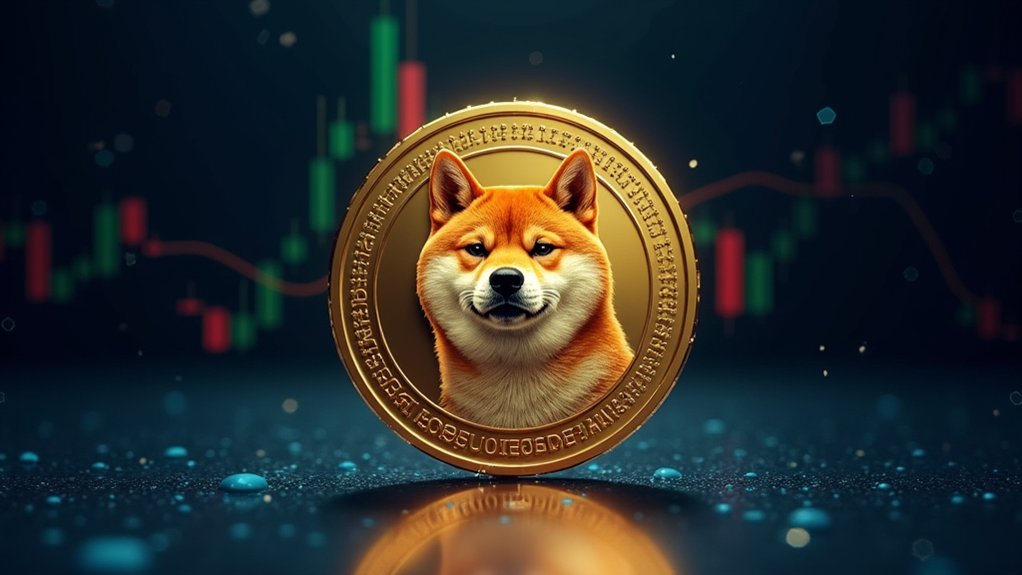Dogecoin originated as a joke cryptocurrency in 2013, featuring the Shiba Inu meme as its mascot. It surged from less than $0.01 to $0.73 in May 2021, reaching an $88 billion market cap despite its unlimited supply. Notable endorsements from Elon Musk and Mark Cuban propelled its mainstream adoption. Unlike Bitcoin, Dogecoin uses Scrypt technology for faster transactions while maintaining its "Do Only Good Everyday" community ethos. This remarkable transformation reveals deeper insights about cryptocurrency's evolving landscape.

Dogecoin's meteoric rise to prominence occurred primarily in 2021 when its value surged from less than $0.01 to an all-time high of $0.73 in May, resulting in a peak market capitalization exceeding $88 billion.
From penny stock to $88 billion phenomenon, Dogecoin's 2021 surge rewrote cryptocurrency history.
This unprecedented growth positioned Dogecoin among the top 20 cryptocurrencies by market value, demonstrating remarkable resilience despite its origins as a parody asset. Unlike most cryptocurrencies, Dogecoin features an unlimited token supply, making it inherently inflationary by design.
The currency's adoption has been significantly influenced by high-profile endorsements. Elon Musk, often referred to as "The Dogefather," has consistently promoted the cryptocurrency through social media.
Mark Cuban's Dallas Mavericks organization accepts DOGE as payment for merchandise, further legitimizing its utility. The community has welcomed the slogan "Do Only Good Everyday," reflecting their commitment to charitable initiatives.
Critics question Dogecoin's fundamental value proposition, citing its unlimited supply as a barrier to long-term price stability.
The concentration of tokens in relatively few wallets raises centralization concerns, while regulatory ambiguity presents additional challenges. Market volatility and susceptibility to manipulation remain significant risk factors for investors.
Despite these challenges, Dogecoin has established practical applications beyond speculative trading.
It functions as a tipping mechanism on social media platforms, facilitates microtransactions, and serves as a donation vehicle for charitable causes. Dogecoin uses Scrypt technology derived from Litecoin's blockchain, enabling faster transaction processing compared to Bitcoin. The coin features a Shiba Inu logo representing its playful origins based on the popular Doge meme from 2013.
As cryptocurrency adoption continues to expand, Dogecoin's journey from meme to mainstream financial instrument illustrates the evolving landscape of digital assets.
Frequently Asked Questions
Can Dogecoin Be Mined With a Regular Computer?
Dogecoin can technically be mined with regular computers, though it's highly inefficient.
CPU mining yields minimal returns while consuming excessive electricity and causing hardware deterioration.
GPU mining offers better performance but remains challenging for profitability. Most serious miners utilize ASIC devices specifically designed for Scrypt algorithm processing.
For average computer users, alternatives like cloud mining services, faucets, or simply purchasing DOGE represent more practical approaches to acquisition.
How Do I Report Dogecoin Earnings on My Taxes?
Dogecoin earnings must be reported based on how they were acquired.
Mining income goes on Schedule C as self-employment income, using fair market value at receipt.
Capital gains from selling Dogecoin are reported on Form 8949 and Schedule D.
Payments received for goods or services should be listed on Schedule 1 as ordinary income.
All cryptocurrency transactions must be disclosed on Form 1040, with proper records maintained for at least three years.
What Security Risks Are Unique to Storing Dogecoin?
Dogecoin storage presents specific security challenges beyond general cryptocurrency risks.
The "DogeReaper" exploit demonstrated network-level vulnerabilities, with 87% of nodes remaining unpatched during the 2024 attack.
Wallet security faces targeted phishing campaigns, exemplified by the $6 million GIGA token theft.
Concentrated ownership increases manipulation potential, while regulatory uncertainty complicates compliance.
Hardware wallets offer stronger protection, but proper key management remains essential for mitigating these Dogecoin-specific threats.
Is Dogecoin's Unlimited Supply a Disadvantage Compared to Bitcoin?
Dogecoin's unlimited supply presents a significant economic disadvantage compared to Bitcoin's capped model.
While Bitcoin's 21 million coin limit creates scarcity that typically drives value appreciation, Dogecoin's continuous minting of 5 billion coins annually leads to inflationary pressure.
This fundamental difference positions Bitcoin as a potential store of value similar to digital gold, while Dogecoin faces perpetual dilution challenges.
The constant issuance requires sustained demand to maintain price stability against an ever-increasing supply.
How Does Dogecoin's Transaction Speed Compare to Other Cryptocurrencies?
Dogecoin processes transactions significantly faster than Bitcoin with a 1-minute block time versus Bitcoin's 10 minutes.
It handles up to 33 transactions per second, outpacing Bitcoin's 7 TPS but falling short of Litecoin's 56 TPS.
While more efficient than some major cryptocurrencies, Dogecoin remains substantially slower than Ripple's 1,500 TPS and traditional payment systems like Visa.
This balance of speed and accessibility makes it suitable for microtransactions and tipping services.
References
- https://www.coingecko.com/en/coins/dogecoin
- https://kyrrex.com/blog/the-story-of-doge-how-a-meme-became-a-leading-cryptocurrency
- https://www.benzinga.com/money/dogecoin-doge-price-prediction
- https://www.coincola.com/blog/what-is-dogecoin/
- https://changelly.com/blog/dogecoin-doge-price-prediction/
- https://nftevening.com/what-is-dogecoin/
- https://dogecoin.com/dogepedia/how-tos/mining-dogecoin/
- https://koinly.io/blog/how-to-mine-dogecoin/
- https://cryptomus.com/blog/how-to-mine-dogecoin
- https://www.investopedia.com/terms/d/dogecoin.asp





